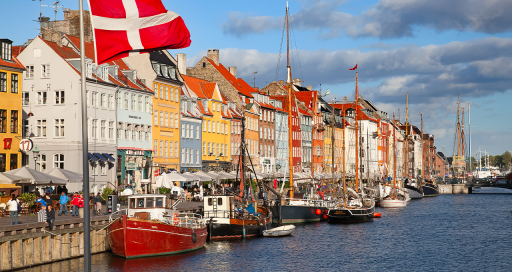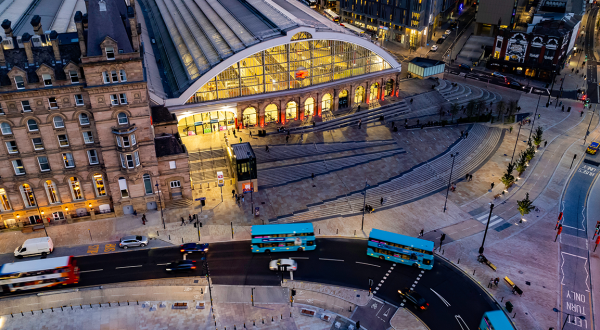Threatened with the risk of coastal flooding and regularly subjected to torrential rain, the Danish capital is undertaking colossal engineering works to absorb the effects of climate change.

An artificial lake, cool islands, cyclable motorways, absorbent pavements – rarely has a city undertaken such an engineering effort to defend itself against the effects of climate change. With more than 300 projects in effect, Copenhagen has emerged as a worldwide laboratory for urban resilience.
But the Danish capital really has no other choice. Built on drained wetland alongside the Øresund strait, Copenhagen is one of the world’s cities most at risk of flooding, with sea levels potentially rising 42 cm by the end of this century and water tables full to capacity.
Added to which, Copenhagen is regularly subjected to torrential rain. Many of the city’s 660,000 inhabitants (more than 10% of Denmark’s population) still remember the day of 2 July 2011, when in just two hours, its streets and buildings were engulfed by 135 mm of water. This was the most violent rainfall recorded in 55 years, and the damage cost a billion euros.
Fully learning the lessons from that disaster, the local authorities launched an ambitious project to manage future torrential rainstorms. Its aim is to protect the city from the potentially devastating effects of water for the next hundred years. The project involves colossal development works, both on the surface and underground.
Emergency reservoirs
One of the most spectacular infrastructure projects is an artificial lake, large enough to store 22,600 m3, in the century-old Enghaveparken public park. All the city’s parks are now considered potential emergency reservoirs.
Formerly a marshy area avoided by local people, the Karens Minde green space has been transformed into a rainwater containment zone. In the event of severe storms, the City of Copenhagen and the water company HOFOR plan to use it for the runoff and storage of 15,000 m3 of rainwater in underground basins. This project forms part of a wider plan to redevelop an entire 35,000 sq. metre district.
In 20 years, GHG emissions have been reduced by 3/4.
In Copenhagen, the climate transition involves both the regeneration of working-class areas and the transformation and rewilding of concreted-over spaces. The city has decided to take control of water and redesign its urban spaces.
In its all-encompassing strategy to combat the effects of climate change, the city is also trialling perforated paving slabs capable of absorbing rainwater and runoff. Water can be stored in a mini water table beneath these “climate tiles” and later reused to water nearby plants.
Underground tunnels
In a city where population density (7,559 people per square kilometre – comparable with São Paulo, Brazil) complicates direct water management, the key battle against flooding is being waged underground.
Copenhagen sits above a network of gigantic underground tunnels designed to absorb, store, redirect and redistribute massive water flows. One of these giant arteries, built under the Valby district, proved its worth in the torrential rains of August 2024. Another 1.3 km tunnel is currently under construction between Copenhagen’s inland lakes at the edge of the port, and is scheduled to open in 2026.
Urban heat and bicycles
The Danish capital has always been in the forefront of the environmental struggle (see sub-article). This calls for strong – and not always consensual – political choices. The construction of Lynetteholm, the huge artificial island between the Nordhavn and Refshaleøen districts intended to be a barrier against rising waters and a location for 35,000 residents and the same number of jobs, has been highly controversial.
The policy on clean energy has proved less contentious, featuring offshore wind turbines, and solar farms on surrounding land. The Danish capital boasts the world’s largest urban heat network, powered almost exclusively by the combustion of waste and biomass, and connected to 99% of the city’s housing.
Copenhagen is a worldwide laboratory for urban resilience.
In terms of mobility, half of urban journeys are made by bicycle. The city invested early in this area, with cyclable motorways and the famous Cykelslangen cycle bridge that winds between the banks of the canal. Around €10 million a year are targeted at cyclable infrastructure. This is not enough, according to some analysts who say that cycling is no longer increasing compared with the use of cars, which are still a significant presence in Copenhagen, especially on the outskirts.
However, in many respects, Copenhagen is setting the standard in the fight against the effects of global warming. As Denmark’s only large city, the capital is inevitably the main focus of the country’s efforts to defend itself against flood risk. In 2023, a new national adaptation plan placed clear emphasis on coastal defences and decentralised governance, with significant delegation to municipal councils. All of which strengthens Copenhagen in its battle for climate resilience.
In the forefront of decarbonisation
The Danish capital has always been in the forefront of the environmental struggle. Housing, transport, waste, alternative energies: every lever for decarbonisation has been applied more quickly and on a larger scale here than elsewhere. In 2009, the city set a target of carbon neutrality by 2025. At the time, this was the world’s only such target.
But neutrality will yet take a while longer: 2027, 2028, 2030? Exactly when depends in large part on the carbon capture and storage potential of Amager Bakke, the iconic waste incinerator with a 465-metre-long ski run on its roof. But Copenhagen has made significant progress toward its objective. In 20 years, greenhouse gas emissions have been reduced by three-quarters, despite the city’s population growing by a quarter in that time, not to mention significant economic growth.
KEY FIGURES
660,000 people live in Copenhagen (and twice that in the wider urban area)
99% of the city’s housing is connected to the world’s largest urban heat network, powered almost exclusively by the combustion of waste and biomass
50% of urban journeys are made by bicycle
€10 million a year are targeted at cyclable infrastructure
09/15/2025



